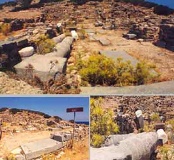Our region
search
Itanos
 The remains of ancient Itanos are situated 27 kms to the East of Sitia near Vai Palm Forest. This area is known as Erimoupli or Ermoupoli.
The remains of ancient Itanos are situated 27 kms to the East of Sitia near Vai Palm Forest. This area is known as Erimoupli or Ermoupoli.
The founding of Itanos can be traced back to the prehistoric era and Homer provides the first written evidence of its existence. It was an important commercial hub on the trading routes between Europe and the Middle East and exported porphyry, sponges, glass and fish.
Itanos dominated the Eastern coast of the region of Sitia and its boundaries extended from the headland of Samonio (Kavo- Sidero) to the headland of Erithreo (Goudouras). The trading links established using products from its territories, combined with the income assured by the Priesthood of Zeus in Palekastro, meant that the town became extremely rich, proof of which can be seen in the remains of many temples and luxurious marble dwellings. Of historical interest is a stone tablet built into the walls of the Monastery of Toplou which informs us that in 146 BC the people of Itanos requested the aid of Ptolemy Filomitora, King of Egypt, in their conflict with the people of Presos. The Pharoah is recorded as having sent military forces including guards. This help sent by the King of Egypt combined with the fact that Presos became embroiled in a conflict with Ierapetra, put an end to the war. However the people of Itanos were not to know peace. A neighbouring war lord invaded Presos and Ierapetra and set his sights on Itanos.
These conflicts continued up until the Roman invasion in AD67. During the Roman era Itanos regained its dominance. The Romans allowed Itanos to mint its own coins and to take part in the Cretan parliament.
Today the visitor can wander through the ruins noting the remains of a large guard tower made from black stone to the west, the ancient Christian church on the east side, the Hellenistic settlement, two Christian churches at the foot of the hills leading to Vai and the cemetery on the outskirts of the city. The city was destroyed by the Byzantines but is believed to have been resettled in Venetian times.
